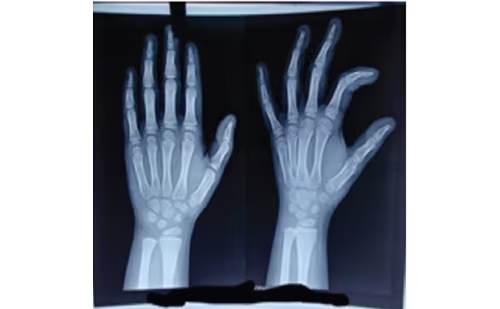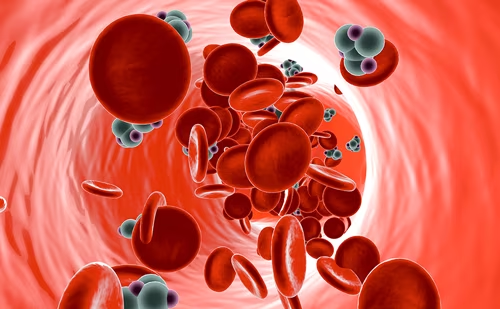Growth/growth hormone/insulin-like growth factors
Evidence has long supported insulin-like growth factor-2 (IGF-2) as an important fetal growth factor. Begemann and co-workers from Germany and the Netherlands report four patients from a multigenerational family with the combination of severe intrauterine and postnatal growth retardation, relative macrocephaly, and Russell–Silver syndrome-like features, found to be caused by a paternally inherited IGF2 nonsense mutation.1 Neurodevelopment ranged from normal to modest impairment. Skeletal maturation typically was delayed by a few years compared to chronological age. Endocrine evaluation showed normal to elevated serum growth hormone (GH) and IGF-1 levels, while serum IGF-2 levels were low for age (246–380 ng/mL). Adult height in three patients ranged from 148.0 to 170.0 cm (-4.0 to -1.6 standard deviation [SD]). GH treatment resulted in modest improvement in height standard deviation score (SDS), with one patient reaching 170 cm.
Adding another piece to the ‘idiopathic’ short stature puzzle, Nilsson et al. describe 11 patients from three families with autosomal dominant short stature.2 Endocrine evaluation, including GH–IGF axis function, was normal. They had features of a skeletal dysplasia, including brachydactyly, short thumbs, and mid-face hypoplasia. Using whole exome sequencing, these patients were discovered to have a heterozygous mutation in ACAN, a gene which codes for aggrecan, a proteoglycan in the extracelluar matrix of the growth plate and other cartilaginous tissues. While most children with short stature have delayed bone age, the unique feature in patients with aggrecan mutation is advanced bone age and premature growth cessation.
Moving from new etiologies to unique treatment paradigms, Backeljauw et al. reported results from the first study of combination GH/IGF-1 therapy in children with short stature.3 In this randomized, multicenter trial, enrolled children were below -2 SD in height, were GH sufficient, but had a serum IGF-1 below -1 SD for age and gender. The rationale for combination therapy was that such children might need an increase in both locally generated IGF-1 (from GH) and systemic IGF-1. In the first year, children treated with GH/IGF-1 grew 9.7–11.2 cm/year (three groups, all receiving the same dose of GH and incremental doses of IGF-1), compared to 9.3 cm/year in the GH alone group (highest IGF-1 dose significantly greater growth velocity vs. GH alone). Improved growth rate was sustained over three years; the GH/IGF-1 group receiving the highest dose gained 1.9 SD in height, compared to 1.3 SD in the GH-alone subjects. Adverse effects were similar in the GH/IGF-1 vs. GH alone, with the exception of a higher frequency of lipohypertrophy and hypoglycemia in patients receiving the combination therapy, perhaps because a significant proportion of these subjects had serum IGF-1 levels >+2 SD.
A potential adverse effect of GH treatment is the risk of neoplasia, either primary or secondary malignancies in children with a history of prior cancer. This issue was explored in a PubMed search carried out by the Pediatric Endocrine Society Drug and Therapeutics Committee.4 In children without a prior history of cancer or known risk factor, the Committee concluded that GH treatment has not been associated with de novo development of cancer. In pediatric cancer survivors, the Committee did not find evidence that GH treatment was a cause of recurrence (or relapse) of their primary cancer. Some studies do report an increased risk of second primary neoplasms in pediatric cancer survivors treated with GH (in particular, meningiomas in children with brain tumors treated with radiation), while others do not find an association. Finally, the Committee concluded that there was insufficient evidence to determine if GH treatment might be associated with primary neoplasms in children with monogenic conditions know to predispose to tumor development, such as neurofibromatosis, Noonan or Fanconi syndrome.
Gigantism and acromegaly
Gigantism, a rare disorder in children, and some cases of acromegaly in adults have been discovered to have a genetic etiology. Previously, familial isolated pituitary adenomas secreting excess GH have been reported to be caused by mutations in the aryl hydrocarbon receptor-interacting protein gene (AIP). Last year, an X-linked form of gigantism due to Xp26 microduplications associated with overexpression of GPR101, a gene which encodes a G-protein-coupled receptor, were reported by investigators from the Section on Endocrinology and Genetics at the National Institute of Health (NIH)5. In addition, mutations in GRP101 were found in some adults with acromegaly.
Central diabetes insipidus
The diagnosis of central diabetes insipidus (CDI) in a child necessitates a diagnostic investigation to determine the underlying etiology. Werny et al. describe their findings in 147 patients with CDI seen between 2000 and 2013 at Seattle Children’s Hospital.6 Whereas in the past, no underlying etiology was discovered in 30–50% of cases, so labeled ‘idiopathic DI’, a specific etiology, was identified in over 80% of cases by these pediatric endocrinologists. Congenital midbrain malformations accounted for 24% (septo-optic dysplasia was the most common), acquired infiltrative disease or brain tumors for 56% (Langerhan cell histiocytosis and craniopharyngioma were the most common, respectively), while genetic/familial causes were present in 7% of cases. Of an initial 22 patients with idiopathic DI, over time, all 12 with normal pituitary stalk on magnetic resonance imaging (MRI) remained idiopathic. However, in the 10 patients with increased stalk thickness, the most worrisome group, three were eventually diagnosed with Langerhan cell histiocytosis and one with a germinoma.
Thyroid
The first ever society guidelines for management of thyroid nodules and differentiated thyroid cancer (DTC) specific to children were developed and published in 2015 by a Task Force of the American Thyroid Association.7 The Task Force recognized that significant differences exist between children and adults. While the incidence of thyroid nodules is lower in children, the percentage of nodules harboring cancer is higher compared to adults. The Task Force recommended that ‘clinical context’ and ultrasound characteristics should be used rather than size alone to identify nodules that warrant pathologic examination by fine needle aspiration. Despite more widespread cancer at presentation as compared to adults, children with DTC have an excellent prognosis. Survival up to 10 years is typically 98%. However, while death from DTC is low, long-term studies report a higher than predicted number of deaths between 30 and 50 years’ follow-up, and many of these resulted from second primary malignancies in patients who received some form of post-operative radiation. Thus, the Task Force developed risk categories of DTC, to try and identify cases where aggressive therapy, e.g., radioactive iodine is indicated, and conversely to limit such treatment in children who are low-risk and unlikely to benefit.
While the risk of medullary thyroid cancer (MTC) in children usually occurs because another family member has been diagnosed with MTC, familial DTC (e.g., papillary thyroid carcinoma) accounts for only 3–9% of all cases of nonmedullary thyroid cancer. Gara et al. report the first genetic mutation causing nonmedullary thyroid cancer.8 These investigators from the National Cancer Institute studied a large kindred where, over three generations, six members developed papillary thyroid cancer and one had a follicular adenoma. They identified a germline mutation in HABP2 in the affected family members. Functional studies of the specific mutation in various cell lines showed increased colony and foci formation and cellular migration, hallmarks of malignant transformation. The investigators conclude that HABP2 functions as a dominant-negative tumor suppressor gene.
Adrenal
Unraveling the genetic basis of ACTH-independent Cushing’s syndrome is important, as several of these disorders are autosomal dominant, and this information allows for detection of at-risk children. Investigators from the Section on Endocrinology and Genetics at the NIH report that gain-offunction mutations in the gene encoding PRKACA, a catalytic subunit of protein kinase A, are a cause of bilateral adrenal hyperplasia.9 Previously, this group had reported that loss-of-function mutations in PRKAR1a causes primary pigmented nodular adrenocortical disease and Cushing’s syndrome. Both of these defects have in common increased cAMP signaling in the adrenal gland. Studies show a dosage-dependent effect, in that patients with greater copy number gains encompassing the PRKACA gene, e.g., triplications vs. duplications, presented at a younger age.
Puberty
Hypogonadotropic hypogonadism (HH) in children, presents with absent or arrested puberty. Different therapeutic options in boys likely depends on desire for future fertility. Gong et al. in Beijing, China investigated the efficacy and safety of pulsatile pump gonadotropin releasing hormone (GnRH) and human chorionic gonadotropin (HCG) treatment in 35 peripubertal boys with HH.10 GnRH was injected via pump every 90 minutes, while HCG was injected IM two days per week for three months, then every other day. After 12–14 months, patients treated with pulsatile GnRH had significantly larger testicular size compared to those treated with HCG. Hormones including LH, FSH, and testosterone were significantly increased with pulsatile GnRH treatment compared with pretreatment. There was no significant difference in growth parameters (height, weight, and body mass index [BMI]). Based on increased testicular size and higher testosterone levels with pulsatile GnRH, the investigators postulated that treatment at the hypothalamic level can improve fertility in boys with HH, but further longitudinal studies are needed to assess effects on spermatogenesis.
The diagnosis of polycystic ovary syndrome (PCOS) during adolescence is challenging, as features of PCOS overlap with normal pubertal development. A panel of international experts organized by the Pediatric Endocrine Society (PES) reviewed the evidence supporting diagnostic criteria for PCOS.11 Moderate to severe hirsutism, as well as moderate to severe inflammatory acne poorly responsive to dermatologic treatment are clinical features suggestive of hyperandrogenism. Biochemical hyperandrogenism is defined as persistently elevated serum total or free testosterone in an adolescent girl with clinical features of PCOS. Given that anovulatory cycles after menarche are common, the diagnosis of oligomenorrhea in adolescents is challenging, as physiologic adolescent anovulation must be differentiated from ovulatory dysfunction. The expert panel suggested a definition of oligo-anovulation as menstrual intervals persistently shorter than 20 days or longer than 45 days in adolescence two or more years after menarche. Additionally, lack of onset of menses by age 15 or two to three years after thelarche is abnormal and warrants further evaluation. Ovarian imaging is not recommended in the diagnostic evaluation of adolescents with suspected PCOS. The diagnostic work-up must exclude other disorders associated with androgen excess, as suspected by history and physical exam. Insulin resistance and hyperinsulinism is prevalent in adolescent girls with PCOS; however, these are not included in diagnostic criteria. Treatment is symptomatic and aims at reducing the risk of comorbidities.
Metabolic bone disorders
The use of zoledronic acid (ZA) in children and adolescents with bone disorders has increased, given its benefits of short infusion time and long duration of action. With increased use of this antiresorptive agent, George et al. from the Children’s Hospital of Philadelphia undertook a retrospective chart review to assess the short term safety profile of ZA.12 Eighty-one children with a variety of bone disorders were included, the most common indications being osteoporosis (33.3%), osteogenesis imperfecta (27.2%), chronic recurrent multifocal osteomyelitis (14.8%), and avascular necrosis (7.4%). Adverse events were noted in 29.9% of all ZA infusions and were more common after first infusion in bisphosphonate naïve subjects. Most frequently seen was hypophosphatemia (25.2%), followed by acute phase reactions (19.1%) and hypocalcemia (16.4%). Subjects with an alkaline phosphatase level >125 U/L were more likely to develop hypocalcemia following first infusion of ZA. There were no life-threatening (anaphylactic) reactions. The use of ZA in the pediatric population is relatively safe in the short term; although adverse events are relatively common, they are self-limited.
Type 1 diabetes mellitus
The risk of hypoglycemia is a major limiting factor in achieving optimal glycemic control in children and adults with type 1 diabetes mellitus. Thanit et al. proposed that extended use of an artificial beta cell, or closed loop insulin delivery system might serve to tighten glycemic control while minimizing hypoglycemia. These investigators performed two multicenter, crossover, randomized controlled trials in 58 patients with type 1 diabetes (33 adults, 25 children).13 The study compared closed-loop insulin delivery (used day and night by adults and at night by children) with sensor-augmented pump therapy over a period of 12 weeks in free living conditions. In adults and children, the mean glucose level, the time spent above target, and episodes of hypoglycemia were decreased in the closed loop system compared to control. Additionally, glucose control as assessed by glycated hemoglobin levels was improved in adults using the closed loop system. This study provides promising interventions in the future to optimize glycemic control and minimize hypoglycemia in patients with type 1 diabetes.
Hypoglycemia
The PES developed guidelines for hypoglycemia management in neonates, infants, and children, in an effort to identify persistent hypoglycemia disorders, diagnose them early and implement treatment so as to prevent neurocognitive delay.14 The first 48 hours of life is a period of transitional glucose regulation; in this time period, normal neonates have plasma glucose concentrations which are lower compared to later in life. After the first two to three days of life, mean plasma glucose levels do not differ from infants, older children, or adults (70–100 mg/dL). Thus, PES recommends that evaluation for persistent hypoglycemic disorders should take place after 48 hours of age. To establish a diagnosis of hypoglycemia, confirmation of low plasma glucose <60 mg/dL must occur using a clinical laboratory method. Diagnostic evaluation starts with a ‘critical sample’ measuring serum HCO3, beta-hydroxybutyrate, lactate, and free fatty acids. Results from these tests point the clinician in the direction of the underlying disorder, such as hyperinsulinism, a hormone deficiency, or an inborn error of metabolism. In cases that appear transient, PES recommend a safety fasting test prior to discharge to ensure that plasma glucose concentration can be maintained above 70 mg/dL. For neonates with a suspected congenital hypoglycemia disorder and older infants and children with a confirmed hypoglycemia disorder, PES recommends that the goal of treatment be to maintain a PG concentration >70 mg/dL.







